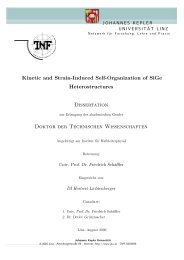Diplomarbeit Diplom-Ingenieur - Institut für Halbleiter
Diplomarbeit Diplom-Ingenieur - Institut für Halbleiter
Diplomarbeit Diplom-Ingenieur - Institut für Halbleiter
You also want an ePaper? Increase the reach of your titles
YUMPU automatically turns print PDFs into web optimized ePapers that Google loves.
20<br />
To derive the change of the beam amplitude the two-beam approximation is<br />
applied. This means that only one diffracted beam is strong. This condition can also<br />
be reached in a real TEM by tilting the sample until only one beam besides the (000)<br />
reflex is strong. The other spots can then be neglected. If one writes now this equation<br />
in terms of the change of the amplitudes when the beam passes through the specimen<br />
along the z direction, one obtains the Howlie - Wehlan equations (eqn. 3.11, eqn.<br />
3.12,) [32].<br />
dφ g πi<br />
−2<br />
πisz<br />
= φ 0e<br />
dz ξ g<br />
πi<br />
+ φ<br />
ξ<br />
dφ0 πi<br />
πi<br />
2πisz<br />
= φ0<br />
+ φge<br />
dz ξ0<br />
ξg<br />
This pair of coupled differential equations can be used to derive the amplitude of the<br />
scattered beam. This gives the intensity of a diffracted beam<br />
Whereas seff is the effective excitation error and is given by<br />
φ<br />
g<br />
2<br />
⎛ t ⎞<br />
⎜<br />
π<br />
= ⎟<br />
⎜ ⎟<br />
⎝ ξg<br />
⎠<br />
s is the excitation error and expresses the deviation from the exact Laue condition and<br />
is also a vector in reciprocal space. Many diffraction spots can be seen even if the<br />
Laue condition is not exactly fulfilled, which is then expressed as K=kD-kI+s. The<br />
intensity of the scattered electron beam is a periodic function of the specimen<br />
thickness t. The period of the oscillations is πseff. seff differs for different diffraction<br />
spots (hkl) and approaches s for very large values of s and becomes ξg -2 if s equals<br />
zero. The periodic behaviour of the electron beams plays an important role in the<br />
interpretability of the lattice fringes in HRTEM images (see section 3.4).<br />
s<br />
eff<br />
2<br />
=<br />
0<br />
g<br />
( )<br />
( ) 2<br />
2<br />
πts<br />
eff<br />
πts<br />
sin<br />
s<br />
2<br />
eff<br />
+<br />
1<br />
ξg<br />
2<br />
(3.11)<br />
(3.12)<br />
(3.13)<br />
(3.14)











